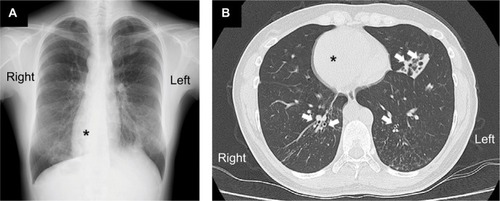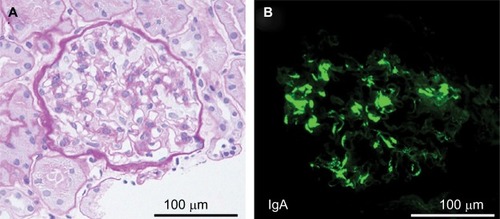Abstract
We herein report the case of a 36-year-old woman with Kartagener syndrome (KS), which is an autosomal recessive disorder defined by a triad of bronchiectasis, sinusitis, and situs inversus, with complications of asymptomatic microhematuria and proteinuria. She was finally diagnosed with biopsy-proven immunoglobulin (Ig) A nephropathy. KS constitutes a subgroup of primary ciliary dyskinesia (PCD) characterized by structural and/or functional ciliary abnormalities resulting in sinopulmonary involvement with varying severity. Our case does not allow us to corroborate the clinical impact of KS and/or PCD as a pathogenic basis for the IgA nephropathy, and each disease might develop independently. However, systematic studies on this topic are quite lacking, so we strongly recommend the accumulation of more cases similar to our own, which would allow us to clarify the nature of this disease state more precisely.
Introduction
Kartagener syndrome (KS) is an autosomal recessive disorder characterized by the triad of bronchiectasis, sinusitis, and situs inversus.Citation1 It constitutes the subgroup of primary ciliary dyskinesia (PCD) characterized by structural and/or functional cili-ary abnormalities resulting in sinopulmonary involvement with varying degrees of severity.Citation2 Ciliary dysfunction results in clinically heterogeneous disorders that may lead to a single organ involvement, such as a congenital heart disease, or result in a syndromic phenotype.Citation3,Citation4 However, there are few reports describing patients with this disease state complicated by glomerulopathy.Citation5–Citation7 In this report, we describe one such case in a patient with complications of asymptomatic microhematuria and proteinuria, which were finally ascribed to immunoglobulin (Ig) A nephropathy.
Case report
A 36-year-old woman with a history of persistent cough and bronchiectasis was referred and admitted to our hospital for the evaluation of asymptomatic microhematuria with a urine protein-to-creatinine (Cr) ratio of 0.64 g/gCr, which had been found by her primary physician a few months previously. She was diagnosed with KS on a clinical basis in her childhood and experienced frequent respiratory tract infections, for which she received several courses of medical care, including the sporadic use of antibiotics and expectorants. A dipstick analysis performed 3 years previously revealed 1+ proteinuria and 1+ occult blood reaction when she was admitted to another hospital for bacterial pneumonia; however, her renal parameters were not regularly monitored after the analysis. She had never smoked and denied the use of any drugs. Her younger brother had also been diagnosed with KS.
At the time of admission, the patient was alert with a blood pressure of 120/71 mmHg. Her heart sounds were on the right side of the chest. Neither peripheral cyanosis nor clubbing of the digits was noted. Renal sonography showed that the right and left kidney long axis dimensions were 10.8 and 11.1 mm, respectively, with normal renal cortex echogenicity, while radiographic studies demonstrated bronchiectasis in the lower zone of both lungs, as well as dextrocardia (). A full blood count demonstrated a white blood cell count of 4,600/µL with normal differentials, a hemoglobin level of 12.4 g/dL, and a platelet count of 32.5×104/µL. Further laboratory analyses revealed the following results: blood urea nitrogen, 8 mg/dL; serum, Cr 0.4 mg/dL; uric acid, 3.8 mg/dL; total protein, 6.4 g/dL; serum albumin, 3.3 g/dL; sodium, 140 mmol/L; potassium, 4.1 mmol/L; chloride, 104 mmol/L; Ca 9.5 mg/dL; phosphorus, 3.2 mg/dL; IgG, 1,793 mg/dL; IgA, 680 mg/dL; IgM, 90 mg/dL; C3, 99 mg/dL; C4, 24 mg/dL; and C-reactive protein, 0.02 mg/dL. A serological study was negative for antimyeloperoxidase antineutrophil cytoplasmic antibody (ANCA), antiproteinase 3-ANCA, and anti-glomerular basement membrane antibodies. A 24-hour urine specimen contained 0.16 g of protein, with a Cr clearance rate of 145.1 mL/min. Renal biopsy, which was performed on hospital day 2 (), revealed two cores of renal parenchyma with nine glomeruli, one of which was globally sclerotic. The rest of the glomeruli demonstrated mild mesangial proliferation and moderate mesangial matrix accumulation. Predominant mesangial depositions of IgA and C3 were observed in an immunofluorescence analysis, while electron microscopy revealed paramesangial electron-dense deposits within a mildly expanded mesangium. Consequently, the patient’s renal abnormalities were ascribed to IgA nephropathy. In accordance with the Japanese therapeutic guidance,Citation8 we prescribed a low protein diet and a periodic monitoring program, consisting of comprehensive renal care, was scheduled.
Figure 1 The radiographic findings.

Figure 2 The renal biopsy findings.
Abbreviation: Ig, immunoglobulin.

Discussion
This report illustrates a rare case in which a renal biopsy performed as a diagnostic investigation for asymptomatic microhematuria and proteinuria led to the discovery of IgA nephropathy in a patient with KS. A spectrum of renal abnormalities, including several glomerular injuries as well as polycystic kidney disease, has been anecdotally shown in patients with the disease.Citation4–Citation7,Citation9 Even patients with end-stage renal failure have been described.Citation10,Citation11 At present, whether or not KS and/or PCD has a pathogenic role in kidney disorders, and the chronic recurrent respiratory tract infections seen in this syndrome or medications for a comorbidity may be associated with certain types of glomerulopathy.Citation5,Citation9 Obviously, systematic studies on this topic are quite lacking, so we strongly recommend the accumulation of more cases similar to our own to clarify the nature of the combination between KS and IgA nephropathy more precisely. To the best of our knowledge, this is the first report of IgA nephropathy as a complication in a patient with KS.
A genetic disturbance characterized by structural and functional abnormalities in the ciliary system leading to impaired mucociliary clearance have received focus under the term PCD.Citation12 Patients with PCD may experience sinopulmonary infections many times and suffer from progressive bronchiectasis.Citation12 Approximately 40%–50% of subjects with the disease may have mirror-image organ arrangement, a clinical variant that is categorized as KS.Citation1,Citation13,Citation14 Since this condition was first described by Siewert and later as a triad by Kartagener in 1935,Citation15,Citation16 the cumulative number of publications on PCD has been slowly growing. In most patients, the diagnosis of this pathology is made in childhood, but there may be some patients who are diagnosed in late adulthood.Citation17 No distinct gender predilection has been recognized,Citation1,Citation3,Citation12 whereas the incidence of the disease remains to be clarified, as the current data are largely limited to retrospective studies and the number of patients with PCD or KS may be underdiagnosed.Citation13,Citation14,Citation18 Nevertheless, Afzelius et al reported their experience, identifying 26 children with PCD among 286,409 children who were born in the study period; thus, the estimated prevalence of PCD, based on the population of the study, was as much as 1 in 11,000 births. Based on this figure, the estimated incidence of KS may be ~1 in 20,000–30,000.Citation7,Citation14,Citation19 Given the rarity of this condition, the lack of reports describing glomerular diseases, including IgA nephropathy among patients with PCD or KS, may not be surprising. Otherwise, the paucity of information regarding glomerular diseases among PCD patients without situs inversus is interesting.Citation5–Citation7,Citation9
IgA nephropathy is recognized as the most common form of primary chronic glomerulonephritis worldwide.Citation8 It is diagnosed based on pathological findings and histological findings that require assessment by light microscopy and immunofluorescence microscopy; thus, there are considerable discrepancies in the incidence reported in previous studies, probably due to the different policies in nephrology centers regarding the selection of patients for renal biopsy.Citation8,Citation20 Asymptomatic renal abnormalities and macroscopic hematuria are known as common clinical manifestations of IgA nephropathy, while isolated microscopic hematuria with minimal proteinuria is regarded as having a favorable prognosis.Citation21 Nevertheless, a proportion of patients will eventually develop hypertension and significant proteinuria, which are also independent predictors of progression to a chronic decline in the renal function.Citation20 Thus, the long-term followup of these subjects should be mandatory.Citation21,Citation22 Our case does not allow us to corroborate the relationship between KS by PCD and IgA nephropathy, and there might not be any shared pathogenic properties for each disease. However, we must bear in mind that this comorbid condition can be seen in ordinary clinical practice and remember that the long-term prognostic implications may be mediated by the form of chronic kidney disease, which has been in focus as a major public health problem worldwide.Citation23 Indeed, IgA nephropathy has been shown to be a significant morbidity. The 20-year cumulative rate of end-stage kidney disease in patients with this condition is reported to be ~40%.Citation8,Citation23
Consent for publication
Written informed consent was obtained from the patient to publish this case report and any accompanying images. The clinicians at our university are not required to obtain institutional review board approval for case reports of a single patient.
Acknowledgments
This study was supported in part by a Grant-in-Aid for Research on Advanced Chronic Kidney Disease, Practical Research Project for Renal Diseases from the Japan Agency for Medical Research and Development (AMED) and by a grant for Private University Research Branding Project from the Ministry of Education, Science and Culture, Japan.
Disclosure
TA is affiliated with an endowed department (Department of Chronic Kidney Disease Pathophysiology) supported by Terumo Co., Chugai Pharmaceutical Co., Ltd., and Kyowa Hakko Kirin Co., Ltd. The other authors report no conflicts of interest in this work.
References
- ChangWJKungWCChiuWYKartagener syndromeQJM2017110852328402566
- PandeyAKMaithaniTBhardwajAKartagener’s syndrome: a clinical reappraisal with two case reportsEgyp J Ear Nose Throat Allied Sci2014153271274
- KennedyMPOmranHLeighMWCongenital heart disease and other heterotaxic defects in a large cohort of patients with primary ciliary dyskinesiaCirculation2007115222814282117515466
- WareSMAygunMGHildebrandtFSpectrum of clinical diseases caused by disorders of primary ciliaProc Am Thorac Soc20118544445021926397
- EgbertBMSchwartzEKempsonRLKartagener syndrome: report of a case with mesangiocapillary glomerulonephritisArch Pathol Lab Med197710129599300013
- KrishnamurthySChoudharyBRajeshNGRameshASrinivasanSKartagener syndrome associated with mesangioproliferative glomerulonephritisPaediatr Int Child Health201232211611822595222
- MomeniADoroushiBTaheriNKartagener syndrome with focal segmental glomerulosclerosisIran J Kidney Dis20137649950124241099
- TominoYDiagnosis and treatment of patients with IgA nephropathy in JapanKidney Res Clin Pract201635419720327957413
- KawasakiYSuzukiJSikeTBucillamine-induced nephropathy in a child with juvenile rheumatoid arthritis and Kartagener’s syndromePediatr Int200042331631810881595
- ImafukuTOgiharaTKudoHHayashiKOhtakeKIyoriSKartagener’s syndrome associated with infundibular pulmonic stenosis, chronic renal failure and azoospermia: a report of a caseJpn J Med19862521951983489117
- OsmanEMAbboudOISulaimanSMMusaARBeleilOMSharfiAAEnd-stage renal failure in Kartagener’s syndromeNephrol Dial Transplant1991610747
- NoonePGLeighMWSannutiAPrimary ciliary dyskinesia: diagnostic and phenotypic featuresAm J Respir Crit Care Med2004169445946714656747
- BarbatoAFrischerTKuehniCEPrimary ciliary dyskinesia: a consensus statement on diagnostic and treatment approaches in childrenEur Respir J20093461264127619948909
- CiancioNde SantiMMCampisiRAmatoLdi MartinoGdi MariaGKartagener’s syndrome: review of a case seriesMultidiscip Respir Med20151011826075070
- SiewertAÜber einen Fall von Bronchiektasie bei einem Patienten mit Situs inversus viscerum. [A case of bronchiectasis in a patient with Situs inversus viscerum]Berl Klin Wochenschr190441139141 German
- KartagenerMZur Pathogenese der Bronchiektasen. I. Mitteilung: Bronchiektasien bei Situs viscerum inversus. [The pathogenesis of bronchiectasis. I. Report: bronchiectasis in Situs viscerum inversus]Beitr Klin Tuberk193383489501 German
- McmanusICMitchisonHMChungEMStubbingsGFMartinNPrimary ciliary dyskinesia (Siewert’s/Kartagener’s syndrome): respiratory symptoms and psychosocial impactBMC Pulm Med20033414641928
- KatsuharaKKawamotoSWakabayashiTBelskyJLSitus inversus totalis and Kartagener’s syndrome in a Japanese populationChest197261156614538074
- AfzeliusBAStenramUPrevalence and genetics of immotile-cilia syndrome and left-handednessInt J Dev Biol200650657157316741872
- HaasMIgA nephropathy and Henoch-Schonlein purpura nephritisJenneteJCOlsonJLSchwartzMMSilvaFGHeptinstall’s Pathology of the Kidney6th edPhiladelphiaLippincott Williams & Wilkins2007423486
- RodriguesJCHaasMReichHNIgA nephropathyClin J Am Soc Nephrol201712467768628159829
- SzetoCCLaiFMToKFThe natural history of immunoglobulin A nephropathy among patients with hematuria and minimal proteinuriaAm J Med2001110643443711331053
- TanakaSNinomiyaTKatafuchiRSecular trends in the incidence of end-stage renal disease and its risk factors in Japanese patients with immunoglobulin A nephropathyNephrol Dial Transplant201833696397128992313
